Ask someone who wants to keep a medaka.
・I want to keep a medaka but I don't know what and how to prepare it.
・I want to increase medaka.
・I don't know how to care for medaka.
The medaka that was swimming lively at the beginning gradually decreased, and finally disappeared.
In fact, breeding medaka is surprisingly difficult due to its depth.
In order to prevent such a result, I wrote this article in the hope that it would be helpful as a reference after discussing the failures, so please take a look.
It's been a long time since I started keeping medaka from my interest. I would like to write some useful information so that people who start keeping medaka will not fail.
White medakas in the sun.
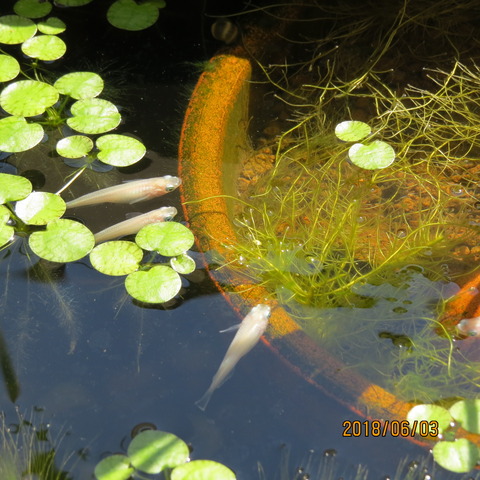
スポンサー広告
◆For those considering medaka breeding
Medaka is the best fish for anyone who wants to keep fish. The body is small, so you don't need a big container, and you can buy 4 kinds of common black medaka, black medaka, white medaka, and blue medaka that you often see in stores.
Outside, you don't have to pay for equipment filters, aeration, lighting, heaters, etc.
Forget about time when you see the swarm swimming after all.I love how I swim coolly, especially on summer mornings and dusk.
◆Breeding of medaka is deep!
However, although killifish are easy to buy, raising them is not that easy. How did you feel when you saw someone else's blog?
Don't you think there is a lot to do when breeding? Did you think that you had to prepare a lot of preparations and prepare them? That's right.It is also a deep and difficult fish.
Medaka is a fish with a strong vitality, but it will show its true value if properly kept. If you don't take good care of yourself, such as changing water, maintaining aquatic plants, feeding, spawning and raising fry, the killifish will die in no time.
Even if you just put it in a container and raise it by yourself, it will be alive to some extent, but it will disappear.It was a series of failures because I started breeding medaka with my ignorance just as I remembered when I was a child.
スポンサー広告
1.Preparation for medaka breeding
Prepare the following 4 items before starting breeding.◆Things to prepare for medaka breeding
・container
Choose a medaka breeding container with a wider swimming space than one with deep water
・Aquatic plants
Choose submerged plants such as matsumo and anacaris
・Soil
Choose Akadama soil, Arakida soil, aquatic plant culture soil
・bait
It may be a live feed such as akamushi or commercial food such as medaka food and pleco.
・Breeding water
Place tap water that has been pumped for about half a day, or add the neutralizing agent and remove the scalp.
◆container
A medaka breeding container. Choose one with more swimming space than one with deep water. The container does not need water lily pots, planters, and bottom holes for flower pots.
Since it breeds, it is necessary to have a container for raising the medaka hatched from eggs, in addition to the container for raising the parent medaka.
The approximate number of individuals suitable for a container is 10 at 30 cm, 20 at 60 cm, and 30 at 90 cm. The larger the container, the greater the amount of water, and the more stable the water temperature and water quality, the lower the risk of medaka having poor body length and death.
Water lilies are available in pottery or FRP, a light fiber reinforced plastic. The plastic and toro vessels used by plasterers are also wide and easy to grow.If you don't care about durability, you can use styrene foam.
The largest container in my home.
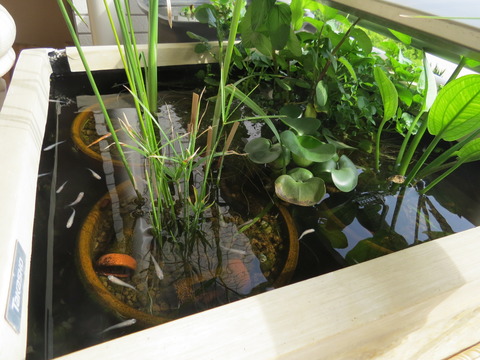
スポンサー広告
◆Aquatic plants
It will be a place for spawning and hideouts for medaka. It prevents medaka spawning eggs and hatched fry from being eaten by other medaka fish.
It is also useful for water purification, and aquatic plants clean up harmful substances such as food residues and feces.
Submerged plants such as matsumo and squirrels, and the floating plant Hotei grass for spawning beds, are aquatic plants that go well with medaka. Matsumo and Anacaris are perennials that can also be wintered, and Hotei grass is a severe annual winter.
You can purchase Matsumo and Anakaris from around 600 yen, and Hotei grass from around 300 yen.
※Hotei grass can be wintered if it is grown indoors in a warm and sunny environment.
The growth of Matsumo and Anakaris is fast, and it is good for growing underwater, but when it grows on the surface of the water, it gradually takes away the swimming space of medaka, weakens due to stress, and dies.
Be sure to thin out aquatic plants. If you observe every day and feel that the space for swimming killifish is running out, you can skip it.
If you do it tomorrow or on the weekend, it will take away the swimming space of the medaka in no time.
I think it's best to plant what you like and what you want to grow.
It's fun to grow big day by day with medaka, and you can also enjoy it if you are a kind of flowering aquatic plant.
However, if you plant a lot of this, the medaka swimming space will eventually decrease and you will die.
Also, when planted directly, the soil becomes rooted and the soil rises and there is no space for the medaka to swim and it will die.直植えをした場合は用土が根だら
Matsumo. A medaka kid is swimming.

スポンサー広告
Akatamachi is colorful and beautiful. Another advantage is that there is little turbidity and it is easy to observe aquatic life. However, aquatic plants also grow, but they do not grow well because they have no nutrition.
You can buy Arakida soil and Akadama soil for about 2L 300 yen.
I would like to recommend Arakida soil as the medium. After all, the place where medaka lives is in the still waters such as rice fields and streams that flow slowly on the sides of the rice fields.
However, because the mud floats up, it is not suitable for ornamental use, and there is nutrient in the Arakida soil, which can lead to eutrophication of water and moss and other algae overgrowth.
In the rice fields, rice absorbs the nutrients, but if you look closely, you can see that water-blooms and moss are everywhere. Also, it does not purify water as cleanly as a river or pond.
Still, I would like to recommend Arakida soil.
After all, the mortality rate of medaka is low, and the incidence rate of the typical medaka disease "slimming disease" is suppressed. There is no problem with the mud rising if you stack red soil.
Arakida soil has some effects and some side effects, but I think it might be worth considering.
It is said that the use of soil does not work like natural filtration, and bacteria that settle in the soil are purified, but it is unnecessary because nutrients in the soil itself deteriorate water quality rather than purification.
If you want to grow in clean, clear water, you can use gravel or stone.
However, it also has the drawback that feces and dust accumulate and the bacteria that settle in the soil are few and are not easily decomposed.
There is also a bare tank called a bottom tank where no soil is used on the bottom floor and the maintenance is prioritized.
However, it has the drawback that stools and debris will accumulate, and that there will be no bacteria that settle in the soil and that it will not be decomposed.
I don't think there is an answer which is better.
◆bait
I tried various kinds of medaka food, but now I am using medaka food and pleco. Pleco especially eats not only medaka but also other aquatic organisms such as southern shrimp and Himetanishi. In particular, it supplements the lack of moss, which is the food of Himetanishi, and the survival rate of Himetanishi is very high.
◆Breeding water
Add tap water that has been pumped for about half a day or one that has been neutralized and decalcified.
If you add a neutralizer, the bleach will come off immediately, but due to the difference in water temperature, it is not recommended to add medaka immediately afterwards. Let's put the killifish in about half a day.
Bacteria break down dirt and clean the water, but initially there are no bacteria.
If you feed medaka in this state, the water will be contaminated with leftover food and feces, and ammonia will increase the number of bad bacteria because biological filtration will not be in time.
With such a mechanism, the water may become cloudy in white.
It is necessary to control feeding as much as possible, and in severe cases it is necessary to change the water, but even if it is completely changed, it will only return to a bacteria-free environment, so wait for the growth of good bacteria.
スポンサー広告
2.Kind of medaka
There are more than 500 kinds of medaka. It is no exaggeration to say that new breeds are being created every day through breeding. The rare varieties that are very valuable for appreciation, from pin to sharpness, lightly cost more than 10,000 yen per animal, and some species cost 1 million yen. If you are not particular about it, you can purchase it cheaply by choosing from the following four standard types.・Black medaka
It is a medaka that is close to the original species that inhabit all over Japan. There are two main types of medaka, Kitano medaka in northern Japan and Minami medaka in southern Japan. Black medaka is an improved variety. However, wild medaka is designated as an endangered species, and I think most of the alien species, Kadashi, can be collected in rivers and ponds in the city.
It is an exotic species native to North America. It looks like a black medaka. It looks like a black medaka. However, since the female grows up to about 6 cm, you will understand when you catch it. Kabayashi invades and lives after the medaka, which has been displaced due to environmental pollution. It is designated as an alien alien species and has penal regulations, and if violated, individuals are imprisoned for up to 3 years, or fines up to 3 million yen, and corporations up to 100 million yen. You cannot take it home or raise it.
Speaking of medaka, I think many people think of medaka. It is a medaka that has obtained citizenship from the black medaka.
It is a beautiful medaka that looks best when kept in a container. However, it is a breed that is difficult to breed because it is genetically weak compared to black medaka and medaka.
Blue medaka is difficult to distinguish from white medaka at first glance, but if you look closely, you can distinguish it because it is bluish. Like white medaka, it is a genetically weak variety that is difficult to breed.
The order in which the vitality is strong among the four types is as follows.
Black medaka > Japanese medaka > White medaka > Blue medaka
3.Medaka breeding environment
It is an important breeding environment for breeding medaka. If the breeding environment is poor, the durable medaka will not grow, and on the contrary, it will become sick and die.・sunlight☀
Nikko, this is the most important. Medaka produces vitamin D by exposing it to sunlight to form strong bones and muscles. Also, if it is not exposed to sunlight for about 12 hours a day, it will not spawn.
The breeding water can be tap water. However, since chlorine is contained in tap water, which is a harmful substance for aquatic organisms such as medaka, descaling is required.
This is the most important breeding environment for killifish. The strong medaka grows in the sunlight. It is said that the sunlit environment is said to be best in the morning and gradually becomes shaded in the afternoon.
The worst daylight environment is in direct sunlight all day or in shade all day. However, be careful of direct sunlight in the summer.
Medaka is a fish that lives in the uncontrolled waters of rice fields, streams, ponds and swamps. The larger the amount of water, the better, but it is said that 1L per animal is a standard.
スポンサー広告
4.Medaka life cycle
It is a lifelong activity of medaka. There is no loss to remember when breeding.・Life of Medaka
It has a short life of 1 to 2 years.
・1 year of medaka
March I wake up from hibernation and eat food
April Start spawning
June Spawning becomes vigorous
October Finish spawning
December Hibernate
Spawning starts when the temperature rises above 15℃. Medaka will incubate at the time of spawning.
Spawning starts when the temperature rises above 15℃. Medaka will incubate at the time of spawning. Spawning is possible when the daylight hours of the day are about 12 hours.
When medaka eggs are isolated, they are eaten almost before hatching. Even if you survive and hide in aquatic plants such as Matsumo and Anacaris, you should think that you can hardly survive.
スポンサー広告
It is a white medaka holding an egg.
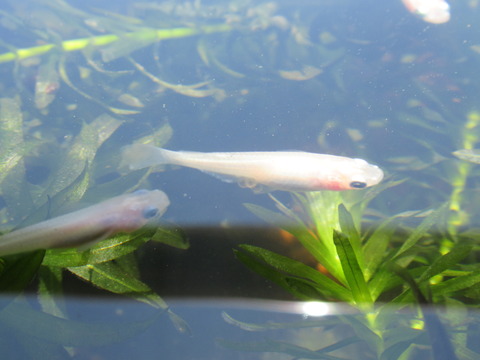
Medaka eggs laid on the spawning bed.
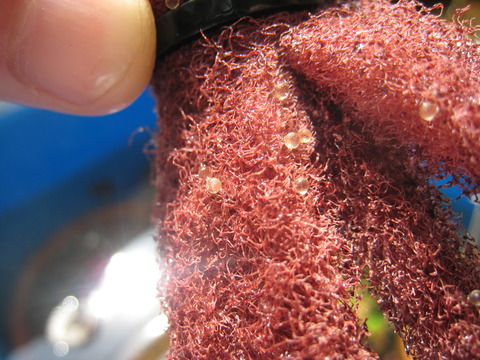
A juvenile medaka fish that has just hatched.
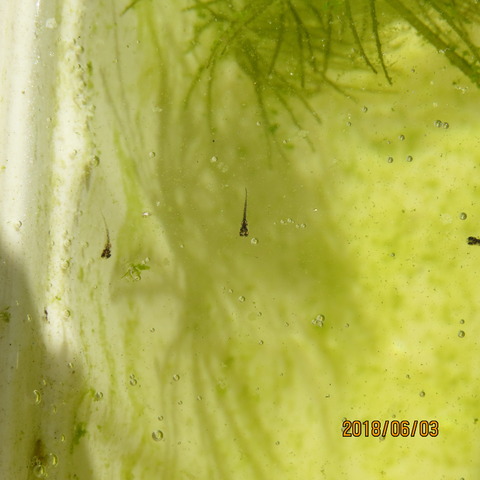
スポンサー広告
5.Medaka rearing cycle
Breeding of medaka fish will take place from March to November.March Replace the water in the breeding container,
Replanting aquatic plants,
Start feeding※1
April Isolation of laid eggs,
Caring for fry(~October)
May Maintenance of too many aquatic plants(~October)
July Take measures against heat(~September)
October Removal of dead aquatic plants,
Put parent killifish and child killifish in the same container
November Finish feeding
December~February next year do nothing※2
Medaka is fed about 3 times a week in the morning or evening.
Do not give it when it is hot during the day as it will cause you to feel unwell.
※2
It is especially dry during the winter, so please add more water.
6.Medaka disease(Illness to lose weight)
If you keep medaka, you will always be worried about "slimming disease".「 "Slimming disease" is not starvation, but it is a disease that causes thinness and death at the end even if feeding is continued. There are various opinions, but the cause is not clear. Although it is such a "thinness disease", it can be prevented to some extent.※Finally
The articles you are viewing may be updated with revisions and corrections due to typographical errors (typographical errors or inappropriate expressions).

![[商品価格に関しましては、リンクが作成された時点と現時点で情報が変更されている場合がございます。] [商品価格に関しましては、リンクが作成された時点と現時点で情報が変更されている場合がございます。]](https://hbb.afl.rakuten.co.jp/hgb/186bfe5b.c71cc0b4.186bfe5c.847cedcf/?me_id=1211165&item_id=10292196&m=https%3A%2F%2Fthumbnail.image.rakuten.co.jp%2F%400_mall%2Fchanet%2Fcabinet%2F1839%2F183561-1.jpg%3F_ex%3D80x80&pc=https%3A%2F%2Fthumbnail.image.rakuten.co.jp%2F%400_mall%2Fchanet%2Fcabinet%2F1839%2F183561-1.jpg%3F_ex%3D128x128&s=128x128&t=picttext)
![[商品価格に関しましては、リンクが作成された時点と現時点で情報が変更されている場合がございます。] [商品価格に関しましては、リンクが作成された時点と現時点で情報が変更されている場合がございます。]](https://hbb.afl.rakuten.co.jp/hgb/186bfe5b.c71cc0b4.186bfe5c.847cedcf/?me_id=1211165&item_id=10117023&m=https%3A%2F%2Fthumbnail.image.rakuten.co.jp%2F%400_mall%2Fchanet%2Fcabinet%2F621%2F61881-1.jpg%3F_ex%3D80x80&pc=https%3A%2F%2Fthumbnail.image.rakuten.co.jp%2F%400_mall%2Fchanet%2Fcabinet%2F621%2F61881-1.jpg%3F_ex%3D128x128&s=128x128&t=picttext)
![[商品価格に関しましては、リンクが作成された時点と現時点で情報が変更されている場合がございます。] [商品価格に関しましては、リンクが作成された時点と現時点で情報が変更されている場合がございます。]](https://hbb.afl.rakuten.co.jp/hgb/186bfe5b.c71cc0b4.186bfe5c.847cedcf/?me_id=1211165&item_id=10311644&m=https%3A%2F%2Fthumbnail.image.rakuten.co.jp%2F%400_mall%2Fchanet%2Fcabinet%2F1881%2F187736-1.jpg%3F_ex%3D80x80&pc=https%3A%2F%2Fthumbnail.image.rakuten.co.jp%2F%400_mall%2Fchanet%2Fcabinet%2F1881%2F187736-1.jpg%3F_ex%3D128x128&s=128x128&t=picttext)
![[商品価格に関しましては、リンクが作成された時点と現時点で情報が変更されている場合がございます。] [商品価格に関しましては、リンクが作成された時点と現時点で情報が変更されている場合がございます。]](https://hbb.afl.rakuten.co.jp/hgb/186bfe5b.c71cc0b4.186bfe5c.847cedcf/?me_id=1211165&item_id=10009472&m=https%3A%2F%2Fthumbnail.image.rakuten.co.jp%2F%400_mall%2Fchanet%2Fcabinet%2F165%2F16120-1.jpg%3F_ex%3D80x80&pc=https%3A%2F%2Fthumbnail.image.rakuten.co.jp%2F%400_mall%2Fchanet%2Fcabinet%2F165%2F16120-1.jpg%3F_ex%3D128x128&s=128x128&t=picttext)
![[商品価格に関しましては、リンクが作成された時点と現時点で情報が変更されている場合がございます。] [商品価格に関しましては、リンクが作成された時点と現時点で情報が変更されている場合がございます。]](https://hbb.afl.rakuten.co.jp/hgb/186bfe5b.c71cc0b4.186bfe5c.847cedcf/?me_id=1211165&item_id=10006441&m=https%3A%2F%2Fthumbnail.image.rakuten.co.jp%2F%400_mall%2Fchanet%2Fcabinet%2F135%2F13585-1.jpg%3F_ex%3D80x80&pc=https%3A%2F%2Fthumbnail.image.rakuten.co.jp%2F%400_mall%2Fchanet%2Fcabinet%2F135%2F13585-1.jpg%3F_ex%3D128x128&s=128x128&t=picttext)
![[商品価格に関しましては、リンクが作成された時点と現時点で情報が変更されている場合がございます。] [商品価格に関しましては、リンクが作成された時点と現時点で情報が変更されている場合がございます。]](https://hbb.afl.rakuten.co.jp/hgb/186bfe5b.c71cc0b4.186bfe5c.847cedcf/?me_id=1211165&item_id=10006442&m=https%3A%2F%2Fthumbnail.image.rakuten.co.jp%2F%400_mall%2Fchanet%2Fcabinet%2F135%2F13587-1.jpg%3F_ex%3D80x80&pc=https%3A%2F%2Fthumbnail.image.rakuten.co.jp%2F%400_mall%2Fchanet%2Fcabinet%2F135%2F13587-1.jpg%3F_ex%3D128x128&s=128x128&t=picttext)
![[商品価格に関しましては、リンクが作成された時点と現時点で情報が変更されている場合がございます。] [商品価格に関しましては、リンクが作成された時点と現時点で情報が変更されている場合がございます。]](https://hbb.afl.rakuten.co.jp/hgb/186bfe5b.c71cc0b4.186bfe5c.847cedcf/?me_id=1211165&item_id=10006455&m=https%3A%2F%2Fthumbnail.image.rakuten.co.jp%2F%400_mall%2Fchanet%2Fcabinet%2F141%2F14031-1.jpg%3F_ex%3D80x80&pc=https%3A%2F%2Fthumbnail.image.rakuten.co.jp%2F%400_mall%2Fchanet%2Fcabinet%2F141%2F14031-1.jpg%3F_ex%3D128x128&s=128x128&t=picttext)
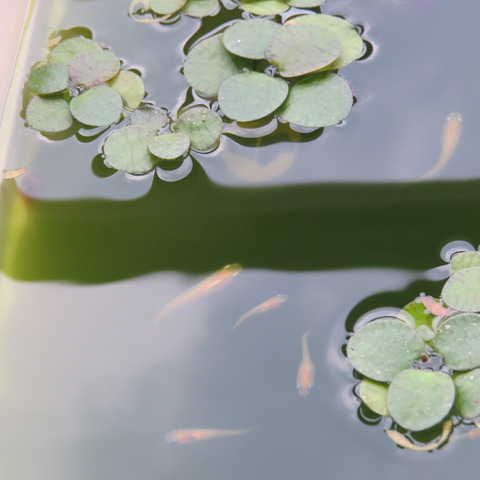
コメント